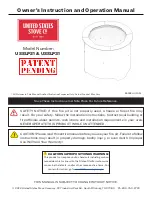
4
Pre-Installation Requirements
FIREPLACE CONDITION AND ZERO CLEARANCE REQUIREMENTS
A masonry fireplace must meet minimum code requirements, National Fire Protection Association, (NFPA) 211,
or the equivalent for a safe installation. Contact a professional, licensed installer, your local building inspector or
the local fire authority for the requirements in your area. Your insurance company should be able to recommend
a qualified inspector.
Inspections should include the following:
1.
Condition of the fireplace and chimney. A masonry fireplace and chimney MUST be inspected prior to
installation of this appliance. They must be free from cracks, loose mortar, creosote deposits, blockage or
other evidence of deterioration. If found, these items MUST be repaired prior to installation. DO NOT REMOVE
BRICKS or MORTAR from existing fireplace when installing this unit.
2.
Chimney Size. Minimum chimney size is 6˝ (152mm) diameter. Maintain a 15 ft. minimum overall chimney
height measured from the top of appliance to the top of the chimney. Chimneys must extend at least 3 ft.
above the roof and at least 2 ft. above the highest point within 10 ft. of the chimney top. See the Chimney
Connections section of this manual.
3.
Zero Clearance or Metal Heatform Fireplaces. These fireplaces and chimneys must meet the minimum code
specifications as noted above. Factory built zero clearance fireplaces must be listed and suitable for solid fuel
use. Chimneys must be at least 7 inch diameter to accommodate a required, continuous, stainless steel liner
from the appliance’s flue collar to the top termination of the chimney. Only detachable parts that can be
easily replaced (i.e. damper parts, screens, doors and side, and back refractory panels) are to be removed.
These parts must be stored and readily available for replacement if the appliance is ever removed. The
removal of any parts that render the fireplace unusable for burning solid fuel requires a permanent label to
be affixed by the installer that states the fireplace is unsuitable for burning solid fuel unless the missing parts
are replaced and the fireplace is restored to its original, certified condition.
4. Chimney Caps. Mesh type chimney caps and spark arrestors must be able to be removed for regular
inspection and cleaning. Otherwise the mesh should be removed to prevent possible plugging. Check your
local fire and building codes.
5. Chimney Liner. The chimney must be suitable for burning solid fuel. Install a continuous stainless steel liner
from the flue collar of the appliance to the top of the chimney. Liner must be UL Listed to UL1777.
6.
Fireplace Opening Dimensions.
A.
Minimum Width
29˝ [737mm]
B.
Minimum Height
23˝ [584mm]
C.
Minimum Depth
14˝ [356mm]
7.
Combustible Material Clearances. The fireplace and
chimney must be inspected to make sure there is
adequate clearance to combustible materials. This
includes the top, side, front, and back as well as
concealed combustibles in the chimney and mantle
areas. Your local building inspector or fire authority
should have information on whether older fireplace
meet current codes and are suitable for use. See also
figure 1 and figure 2.
D.
Min. Distance to Sidewall
9˝ [228mm]
E.
Min. Distance to Top Trim
14˝ [355mm]
F.
Min. Distance to Mantle
19˝ [482mm]
G.
Min. Distance to Side Trim
9˝ [228mm]
H.
Min. Floor Protector Front
12˝ [304mm]
I.
Min. Floor Protector Side
6˝ [152mm]
Min. Floor Protector Side Canada ....8” [203]
8. Makeup Air Requirements. This appliance requires
an adequate supply of makeup air to operate safely
and efficiently. In some areas, this is a building code
requirement. Inadequate air supply will cause poor
combustion, inefficient operation, creosote buildup,
back drafting and smoke puffing into the living areas. If
any of the following conditions are evident, a makeup
air supply MUST be installed.





































